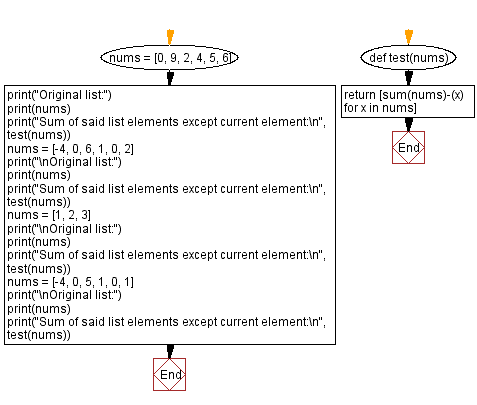Python Exercises: Sum of all list elements except current element
Sum Excluding Index
Write a Python program to add all elements of a list of integers except the number at index. Return the updated string.
Example: ([1, 2, 3]) -> [1+2+3-1, 1+2+3-2, 1+2+3-3]
-> [5, 4, 3].
Sample Data:
([0, 9, 2, 4, 5, 6] -> [26, 17, 24, 22, 21, 20]
([-4, 0, 6, 1, 0, 2]) -> [9, 5, -1, 4, 5, 3]
([1, 2, 3]) -> [5, 4, 3]
([-4, 0, 5, 1, 0, 1]) -> [7, 3, -2, 2, 3, 2]
Sample Solution:
Python Code:
# Define a function named 'test' that takes a list 'nums' as input.
def test(nums):
# Use a list comprehension to calculate the sum of all elements in the 'nums' list,
# and then subtract each element 'x' from the total sum. This gives the sum of all elements except the current one.
return [sum(nums) - x for x in nums]
# Define the original list 'nums'.
nums = [0, 9, 2, 4, 5, 6]
print("Original list:")
print(nums)
# Call the 'test' function to calculate the sum of elements except the current element for each element in the list.
print("Sum of said list elements except the current element:\n", test(nums))
# Define another list 'nums'.
nums = [-4, 0, 6, 1, 0, 2]
print("\nOriginal list:")
print(nums)
# Call the 'test' function for the second list of numbers.
print("Sum of said list elements except the current element:\n", test(nums))
# Define another list 'nums'.
nums = [1, 2, 3]
print("\nOriginal list:")
print(nums)
# Call the 'test' function for the third list of numbers.
print("Sum of said list elements except the current element:\n", test(nums))
# Define another list 'nums'.
nums = [-4, 0, 5, 1, 0, 1]
print("\nOriginal list:")
print(nums)
# Call the 'test' function for the fourth list of numbers.
print("Sum of said list elements except the current element:\n", test(nums))
Sample Output:
Original list: [0, 9, 2, 4, 5, 6] Sum of said list elements except current element: [26, 17, 24, 22, 21, 20] Original list: [-4, 0, 6, 1, 0, 2] Sum of said list elements except current element: [9, 5, -1, 4, 5, 3] Original list: [1, 2, 3] Sum of said list elements except current element: [5, 4, 3] Original list: [-4, 0, 5, 1, 0, 1] Sum of said list elements except current element: [7, 3, -2, 2, 3, 2]
Flowchart:

For more Practice: Solve these Related Problems:
- Write a Python program to generate a new list where each element is the sum of all other elements in the original list excluding the current index.
- Write a Python program to determine which index exclusion yields the maximum sum from a list of integers.
- Write a Python program to compute a list of sums where each sum is the total of the list minus the element at that index, then compare these sums to a target value.
- Write a Python program to return both the modified list and the index that results in the highest exclusion sum.
Go to:
Previous Python Exercise: Count lowercase letters in a list of words.
Next Python Exercise: Find the largest odd number in a list of integers.
Python Code Editor:
What is the difficulty level of this exercise?
Test your Programming skills with w3resource's quiz.
